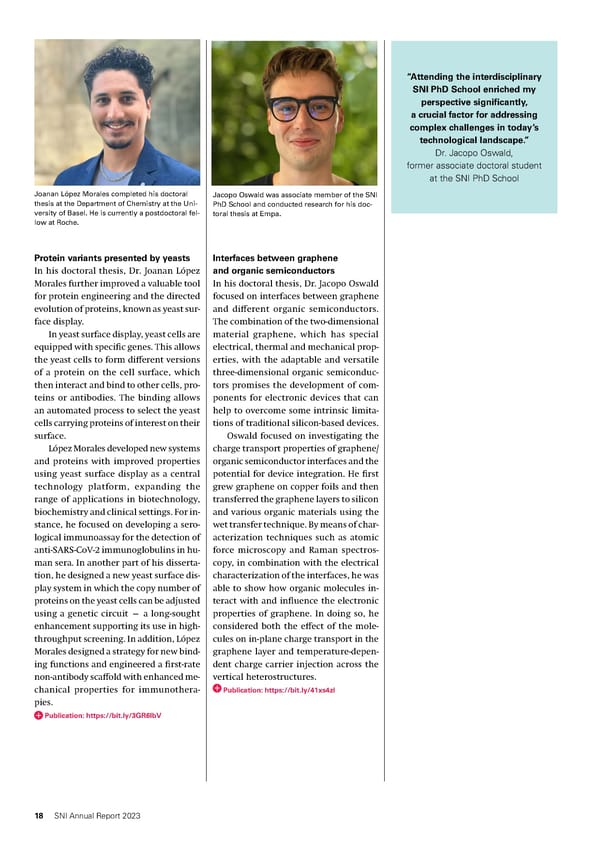“Attending the interdisciplinary SNI PhD School enriched my perspective signi昀椀cantly, a crucial factor for addressing complex challenges in today’s technological landscape.” Dr. Jacopo Oswald, former associate doctoral student at the SNI PhD School Joanan López Morales completed his doctoral Jacopo Oswald was associate member of the SNI thesis at the Department of Chemistry at the Uni- PhD School and conducted research for his doc- versity of Basel. He is currently a postdoctoral fel- toral thesis at Empa. low at Roche. Protein variants presented by yeasts Interfaces between graphene In his doctoral thesis, Dr. Joanan López and organic semiconductors Morales further improved a valuable tool In his doctoral thesis, Dr. Jacopo Oswald for protein engineering and the directed focused on interfaces between graphene evolution of proteins, known as yeast sur- and di昀昀erent organic semiconductors. face display. The combination of the two-dimensional In yeast surface display, yeast cells are material graphene, which has special equipped with speci昀椀c genes. This allows electrical, thermal and mechanical prop- the yeast cells to form di昀昀erent versions erties, with the adaptable and versatile of a protein on the cell surface, which three-dimensional organic semiconduc- then interact and bind to other cells, pro- tors promises the development of com- teins or antibodies. The binding allows ponents for electronic devices that can an automated process to select the yeast help to overcome some intrinsic limita- cells carrying proteins of interest on their tions of traditional silicon-based devices. surface. Oswald focused on investigating the López Morales developed new systems charge transport properties of graphene/ and proteins with improved properties organic semiconductor interfaces and the using yeast surface display as a central potential for device integration. He 昀椀rst technology platform, expanding the grew graphene on copper foils and then range of applications in biotechnology, transferred the graphene layers to silicon biochemistry and clinical settings. For in- and various organic materials using the stance, he focused on developing a sero- wet transfer technique. By means of char- logical immunoassay for the detection of acterization techniques such as atomic anti-SARS-CoV-2 immunoglobulins in hu- force microscopy and Raman spectros- man sera. In another part of his disserta- copy, in combination with the electrical tion, he designed a new yeast surface dis- characterization of the interfaces, he was play system in which the copy number of able to show how organic molecules in- proteins on the yeast cells can be adjusted teract with and in昀氀uence the electronic using a genetic circuit — a long-sought properties of graphene. In doing so, he enhancement supporting its use in high- considered both the e昀昀ect of the mole- throughput screening. In addition, López cules on in-plane charge transport in the Morales designed a strategy for new bind- graphene layer and temperature-depen- ing functions and engineered a 昀椀rst-rate dent charge carrier injection across the non-antibody sca昀昀old with enhanced me- vertical heterostructures. chanical properties for immunothera- Publication: https://bit.ly/41xs4zl pies. Publication: https://bit.ly/3GR6lbV 18 SNI Annual Report 2023
 Annual Report 2023 Page 17 Page 19
Annual Report 2023 Page 17 Page 19